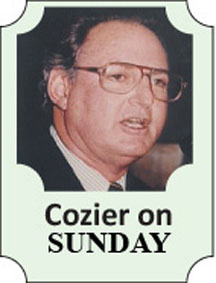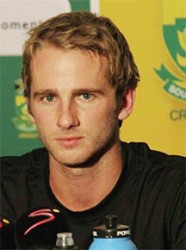After New Zealand’s seminal triumph in their hard-fought, wildly fluctuating Test series against West Indies, Kane Williamson described the team as “a positive and a good young group that can win a lot in the coming years and ultimately move higher and higher in the rankings.”
It was impossible to deny his optimism. The average age of the squad that completed its first overseas triumph against significant opponents in 12 years was 26; only the confident, assertive captain Brendon McCullum, 33, and Ross Taylor, 30, were older.
Williamson himself is 23 and already spoken of back home in the same breath as Martin Crowe, even by Crowe himself. Player of the Series, his 113 in the first Test at Sabina Park and unbeaten 161 in the third at Kensington Oval was high class batting that lifted his tally to seven hundreds, the same number as Crowe’s at the same age. His first was in Sri Lanka on debut, aged 19.
The ICC ranks him 14th among Test batsmen; he is certain to rise quickly. Taylor is ninth, McCullum 19th. Of the trio of swing bowlers who rarely offered West Indies respite, Tim Southee is sixth, Trent Boult ninth and Neil Wagner 22nd.
The only West Indians in ICC’s top 20 are Shivnarine Chanderpaul, now two months away from his 40th birthday, fifth on the batting list and Kemar Roach, impressively recovered from a shoulder operation last October, tenth among bowlers.
A more pertinent guide is the teams’ rankings. New Zealand are seventh on the list, West Indies eighth. In other words, their recent meeting was akin to a Wimbledon first round match between two unseeded players.
Sterner examinations are ahead for New Zealand – three Tests against Pakistan in the Emirates in November, two against Sri Lanka at home in January, two each away to England and Sri Lanka next summer.
 Williamson’s confident prediction can then be properly assessed.
Williamson’s confident prediction can then be properly assessed.
West Indies have the welcome cushion of two home Tests against hapless Bangladesh in September before the daunting prospect of three against No 2 South Africa in December and January.
The selectors would be well advised to take note of Williamson’s words, “a positive and a good young group”; the Bangladesh mini-series is the ideal opportunity to introduce positive, young West Indians.
There are unmistakable signs that the considerable powers of Chanderpaul and Chris Gayle are starting to wane. Chanderpaul turns 40 in August; he has been a Test cricketer since he was 19. Gayle’s fitness is being increasingly tested by the strain of cricket of all types all over the planet.
Marlon Samuels, one of the game’s most prolific batsmen in his golden period just two years ago, has now regressed out of the team.
It is pertinent that youth was to the fore against New Zealand.
Roach, 26, returned to his best after eight months of inactivity while his shoulder healed. Dependent on his fitness (a proviso with all contemporary fast bowlers) he can lead the attack for years to come.
Kraigg Brathwaite, the 21-year-old opener, instantly responded to his recall with a Man of the Match 129 in the second Test victory and the topscore 68 in the first innings of the third.
Jermaine Blackwood, the 22-year-old dasher, came to prominence with three successive hundreds in the regional first-class final against the Windwards and against touring Bangladesh ‘A’. He stroked 63 on debut before he was jettisoned to boost the numerically limited bowling in the final Test.
At 23, Jason Holder made an encouraging, belated entry into Test cricket at Kensington Oval. His tight, bouncy fast-medium bowling had already earned him 18 ODIs; his batting was an unknown quantity until he calmly compiled 38 and 52 in the Test. It hinted that an all-rounder, that currently rare West Indian breed, is in the making.
Darren Bravo, still just 25, scored his first hundred in the Caribbean, and at home at the Queen’s Park Oval to boot; it is inconceivable that he would allow his obvious ability to be wasted through repeated slashes to gully that brought his downfall in each innings at Kensington.
Kieran Powell surrendered his place to Brathwaite when the selectors ran out of patience waiting for him to put together a meaningful score; at 24, his time as a Test opener is hardly at an end.
Both he and Bravo have a couple of hundreds against Bangladesh, Powell in the same Test. It is a record to lift their confidence against the Bangladeshis in St Vincent and St Lucia prior to the trial in South Africa.
There are other promising, potential recruits from the ‘A’ teams that have performed consistently against their counterparts from India, both at home and in India, Pakistan, Bangladesh and Sri Lanka.

The strong Jamaican left-armer Sheldon Cottrell, 24, Miguel Cummins, 23, and Shannon Gabriel, 26, are fast bowlers with a future. Carlos Brathwaite, 23, has the makings of the all-rounder the Test team so glaringly lacks. Leon Johnson, 27, the middle order left-hander, was drafted into the squad in the New Zealand series, a recognition of his late development
Whatever talent there is and as much as the board plans to boost domestic standards through increased contracts for players, improved pitches and an extended first-class season, West Indies as a whole will make no progress until they shed the lack of self-belief ingrained after two decades of disappointment.
It was again evident against New Zealand.
Their spirit in transforming a hiding in the first Test at Sabina Park, by 186 runs in four days, into categorical victory by 10 wickets in the second at the Queen’s Park Oval reversed a sequence of five losses in six Tests. It was a thorough team effort in which everyone was involved
The customary response to adversity had been further disintegration; now there was optimism that such frailty was at an end.
It took the five days of the decisive match to negate the notion.
For the first three, West Indies held sway even as their familiar inability to seize the moment once more took hold.
Replying to New Zealand’s modest first innings 293, they were 153 for one quarter-hour before rain intervened on the second afternoon. A platform was laid for a lead similar to the decisive 239 in the second Test; in the end, it was an insignificant 24. From there on, their lack of conviction brought the opposition back into contention
There was a definite momentum shift. McCullum’s immediate declaration the following morning recognized it. He offered the West Indies the bait of scoring 308 at the plausible rate of 3.14 runs to win the match and take the series
As was predictable, based on past evidence, the prospect of victory was never a consideration after the first three wickets fell for 31 in the first 10 overs; by tea, it was 144 for seven.
It required an eighth-wicket partnership between Holder and the No 9 Shane Shillingford, to show what might have been, delaying the New Zealanders their elation until the sun was slowly setting over Kensington Oval.
It was a familiar ending with a familiar cause.








